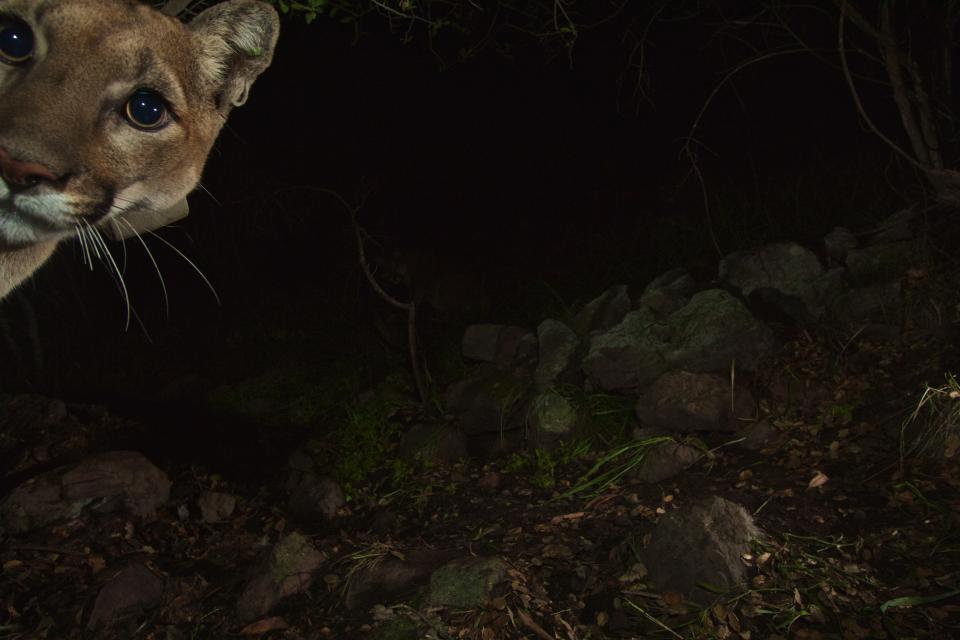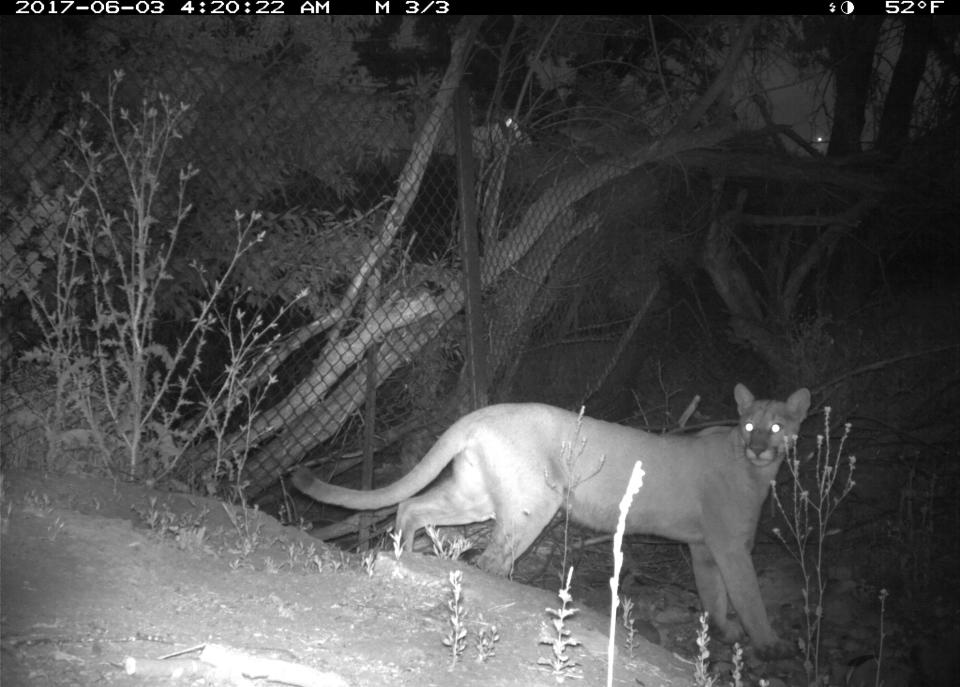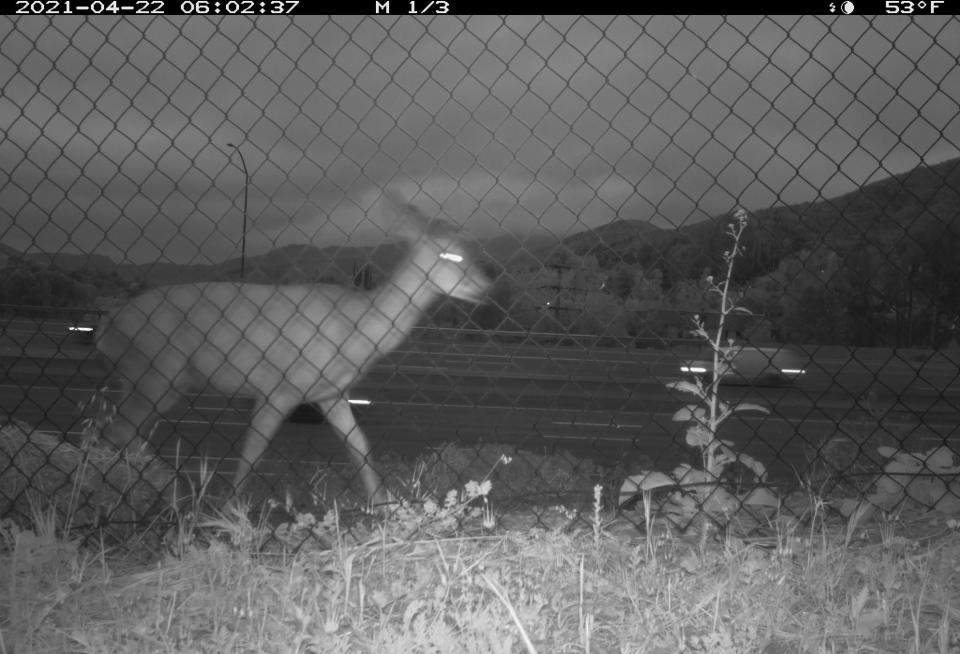Amid roadkill epidemic, California builds world’s largest wildlife bridge
AGOURA HILLS, Calif. - The 10-lane freeway that slices through this part of Southern California is one of the busiest in the country, ushering more than 300,000 cars across the greater Los Angeles area every day.
For drivers, it’s a nightmare: This stretch of Highway 101 is known as the “highway from hell,” the infamous host of the nation’s worst commutes.
But if the 101 is bothersome for bipeds, it is downright disastrous for the wildlife that also calls the region home. The 101 cuts like a chain saw through a vibrant natural ecosystem of coastal sage scrub and oak trees interspersed with suburban neighborhoods, disrupting the movement of animals and threatening their survival.
Now a massive infrastructure project is underway to suture together the vast tracts of fragmented wildlife habitat that have been separated by the highway for decades. Construction on a key phase of the Wallis Annenberg Wildlife Crossing - a $100 million structure funded by a mix of public and private money - began last month and it is expected to open in early 2026.
The bridge will be the largest of its kind in the world, spanning the highway at roughly the size of a football field, and it will reconnect the undeveloped sections of the Santa Monica Mountains with those of the Simi Hills. The new pathway will be a boon for the rare and struggling species that are trying to subsist amid the sprawl, especially mountain lions, whose local population could perish without it, say the scientists who study the animals.
The crossing has inspired an influx of government and philanthropic investment for similar ventures across the country, and it has become a beacon of cohabitation during an age indelibly shaped by human activity, when many of Earth’s vulnerable species are facing the prospect of extinction propelled by a roadkill epidemic. If a wildlife crossing can work in the cradle of American car culture, proponents say, then it can work anywhere.
“When the number one threat to wildlife worldwide is the loss of habitat, we can’t write these places off,” Beth Pratt, the project’s lead fundraiser and chief spokesperson, said of urban areas like Los Angeles. “Environmentalists like me usually don’t like bulldozers, but this is the world’s most hopeful construction site.”
Like most crazes in this city of stars, the wildlife crossing only really became trendy after a celebrity sighting.
P-22, likely the most lionized mountain lion to ever prowl the planet, was first spotted in L.A.’s Griffith Park more than a decade ago, and shortly thereafter he became the premier poster cat for valiant survival against all odds - as well as the project meant to save his feline relatives.
The cougar arrived in the heart of the city after an improbable 50-mile journey that took him across two major freeways, which have increasingly become death traps for his species. P-22 captured the heart of a city that too often feels estranged from its surrounding wilderness, and he spotlighted the plight of other mountain lions corralled by roads.
Pratt, the National Wildlife Fund’s California executive director, took to carting around P-22 stuffed animals and a life-size cougar cutout as she pressed wealthy Angelenos to donate to the Annenberg crossing. After P-22’s death in late 2022, due in part to a car strike that badly injured him, the cat continued to be a potent booster.
“This is really his legacy,” said Pratt, standing at the construction site in Agoura Hills. “P-22 has become like a Marilyn Monroe or a Jim Morrison. He doesn’t die.”
(And like his famous forebears, P-22 has a copycat following in his footsteps: In recent days, another mountain lion was spotted in Griffith Park, delighting scientists and neighbors.)
While P-22 and his apparent successor probably did not traverse the route that will be linked by the crossing, other Santa Monica Mountain pumas badly need the path, Pratt said.
Jeff Sikich, a National Park Service biologist who has been studying the region’s big cats for more than two decades, has watched in real time the catastrophic impacts of a hemmed-in habitat. The Santa Monica lions, effectively on an island south of the 101 and west of Interstate 405, saw their genetic diversity plummet as inbreeding became more common.
Soon, Sikich and his research partners observed the unmistakable signs of an “extinction vortex”: Kinked tails, holes in hearts and other birth defects that prevented reproduction, all traits found a generation earlier in the Florida panther, when it was on the verge of dying out.
“The crossing could not have come at a better time to help our small, isolated population,” Sikich said.
For someone who has spent his career identifying threats to wildlife, scooping up dead animals and publishing morbid findings, the crossing provides a rare dose of optimism.
“To see such a hopeful project, something that will actually be a game changer in this area, it’s super exciting,” Sikich said. “It’s conservation in action.”
Even though mountain lions will benefit big time, they’re also something of a Trojan horse: Donors are drawn to the charismatic carnivores’ cause, but a wide range of species will be able to make use of the crossing.
Bobcats, coyotes, mule deer, some 400 types of birds and dozens of different reptiles and amphibians live in the Santa Monica Mountains, including a high concentration of threatened and endangered species. Many of these animals are in a similar situation as the cougars, badly in need of more room to roam but locked in place without the bridge.
The crossing’s engineers hope that their meticulous design will accommodate every creature that needs it. For years, planners have been gathering seeds from nearby native plants and collecting local fungi to ensure the soil composition on the bridge is just right. The goal, essentially, is to ensure that anything crawling, slithering, hopping or bounding across does not sense they are traveling over something man-made.
“We’re not designing a crossing solely for the mountain lion. We’re creating this diverse ecological stitch across the freeway,” said Robert Rock, a landscape architect and lead designer of the project. “We’re designing from the microbial activity in the soil all the way through to the apex predator.”
Caltrans, the state’s transit agency tasked with overseeing construction, is typically more concerned with facilitating human travel. But this project reimagines that mission. Instead of paving over the natural world, planners must extend the natural world over an immense stretch of pavement.
To be successful, they have to contend with the ubiquitous freeway features that often scare off animals. To combat light pollution, crews poured a special mix of less reflective concrete for the structure’s exterior. And to dull the deafening freeway noise, which comes primarily from tire friction, Rock is insulating the overpass with vegetated barriers that will better absorb sound waves. The pricey project also required significant public buy-in, as it involves partial overnight closures of the 101 during part of the construction.
For the Santa Monica Mountains Conservancy, the state-run agency that acquired and preserved the land that will be reconnected, the crossing will be a blueprint for future projects.
“This is very expensive, but it’s a prototype basically,” Rorie Skei, the conservancy’s chief deputy director, said of the new crossing. “We think going forward, we’ll be able to promulgate more crossings at less cost.”
The California project has heralded a stateside momentum shift in the relatively new discipline of road ecology, the study of how streets and highways impact the environment.
In 2021, Congress made its first big investment in wildlife crossings, setting aside $350 million as part of the bipartisan infrastructure package. One year later, California began allocating huge sums from its general fund to help build more crossings. On top of a $26 million contribution from philanthropist Wallis Annenberg and her foundation, the state has kicked in nearly $60 million for the crossing that will bear her name.
“With projects like this, we’re reconnecting and restoring habitats so future generations can continue to enjoy California’s unmatched natural beauty,” Gov. Gavin Newsom (D-Calif.) said in a recent statement.
Planning for at least 12 more major crossing structures is underway across the state, said Fraser Shilling, the director of the Road Ecology Center at the University of California at Davis - a development he attributes to the Annenberg project.
“Before that, there wasn’t really a discussion; they were seen as impractical and too expensive,” Shilling said. “It helped crack a dam that’s been in place for a long time.”
But, Shilling cautioned, the state’s massive budget deficit could hamper construction and may imperil additional investments in the near future.
And even though California is building what experts consider a superlative structure, the state is already late to the wildlife crossing party. The earliest such overpasses appeared in Europe in the 1960s and spread throughout the world.
In the United States, Utah was the first to build an overpass in 1975, and New Jersey built its “Bunny Bridge” a decade later, both over freeways. Since the turn of the century, construction has accelerated, often in red states not commonly friendly to environmentalist causes.
Gators and panthers in now resurgent numbers navigate Florida’s 60 crossings, mule deer and pronghorn traverse a highway overpass in Wyoming and humans share a land bridge with bobcats in Texas. In an America riven by polarization, wildlife crossings are an unlikely unifier - bridges literally and symbolically over a divided nation.
“It’s now bipartisan because the blue states have caught up,” said Shilling. “There are very few things right now that feel like they can be bipartisan and this is one of them.”
There are practical reasons for this bonhomie: Some 200 people are killed in wildlife-vehicle crashes every year and another 26,000 are injured. The federal government estimates animal collisions cost Americans $10 billion annually.
Wildlife crossings are not a panacea for a problem of that magnitude, Shilling said, and governments must also invest in less grandiose solutions, such as fencing, culverts and tunnels. With so many species on the verge of dying out and cities continuing to expand into their habitats, he said, projects need to happen fast.
At the construction site in Agoura Hills, the urgency is clear.
From the foot of the Santa Monica Mountains, looking north toward the 101 and the Simi Hills beyond, it is difficult to image a more dangerous trek than one through speeding Teslas and barreling semis.
But soon, if all goes as planned, the jaunt will get easier. The nearby crossing - rising one concrete beam at a time - could give wildlife stuck on either side something every Angeleno dreams about: A chance to escape the traffic.
GRAPHICS
https://washingtonpost.com/documents/8e6a9e6c-2c7c-4e8a-b3d4-58a631e3a552.pdf
Related Content
Trump makes sweeping promises to donors on audacious fundraising tour
Fentanyl is fueling a record number of youth drug deaths
In a place with a history of hate, an unlikely fight against GOP extremism





